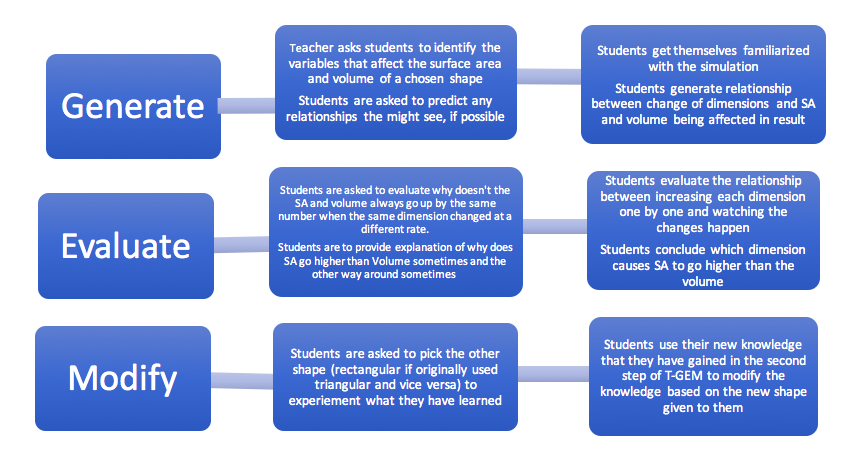I have had the opportunity to teach an enriched class of grade 8 students who are expected to learn a little more than what cover the curriculum. Thinking back to the time when I was teaching the surface area and volume unit, I wanted to do something more than just a few difficult problems at the end of the unit for these students. I decided to get my students to inquire about the relationship between a prism’s surface area and volume. After looking at the results of this activity, I think I had overestimated these students’ abilities as this lesson did not go so well. I ended up using some difficult problems at the end of the lesson to make sure the students got something out of this lesson.
Anyhow, looking back at this experience now, I think T-GEM would have been a great TELE for me to use for this lesson. Instead of asking students to inquire using paper and pen, including technology would have been extremely helpful. After doing the readings for this lesson, I realized that T-GEM would work great for this activity as it will require an online simulation and some probing on the teacher’s part during the activity and students will be putting on their inquiry hats while comparing numbers and getting deeper understanding of the concept.
The main outcome of this lesson is expected to be that students are able to get a visual understanding of how 3D shapes change when the dimensions are changed and how to use minimum surface while getting maximum volume of a 3D shape. My students were not able to do the latter part using paper and pen as it required an overwhelming number of calculations that ended up getting the students frustrated.
My 3-step T-GEM cycle plan includes an online simulator- http://www.shodor.org/interactivate/activities/SurfaceAreaAndVolume/

This online simulator allows you to change dimensions of a 3D shape and instantly gives you the surface area and volume of the shape. I will use this online simulator to help my students understand the relationship between the dimension change and SA and volume. Their task will be to minimize SA while maximizing volume of rectangular or a triangular prism using this online tool.
I think T-GEM is a great resource for activities as such and I am excited to try this out with my grade 8 honors class next year. Best thing that I like about T-GEM is that it is a full package. It starts with inquiry based learning and probing students to inquire about new things on their own to get their feet wet, then it gets students to make relationships using their inquiry knowledge and leading them to be able to modify the knowledge that they have gained in this process to be able to apply to a new scenario. And all of this is done in a TELE setting which really makes this whole process much more efficient and engaging for the students. T-GEM really is a gem!!
Hi Gursimran
I like the fact that you shared your classroom experience with us. I have not taught an enriched class — I have taught the other end of the spectrum and we had a lot of fun. There were no expectations or pressures from outside sources.
I wonder how the students were selected for the enriched class? Were there interviews or was based on the previous years’ grades?
A good next step might be to have the students to use MS Excel to come up with formula/graphs to test out their theories
Christopher
That’s a great idea, Christopher! I will keep that in mind.
I think these students take a test before entring high school and if they get a certain score or above, they get to sign up for the honors class. I have seen this first hand happen in both Surrey and Delta school districts.
GK